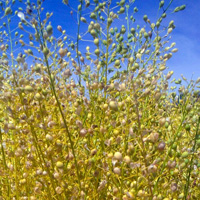Camelina (Camelina sativa L. Crantz) under low-input management systems in northern Italy: Yields, chemical characterization and environmental sustainability

Accepted: 19 April 2020
HTML: 175
All claims expressed in this article are solely those of the authors and do not necessarily represent those of their affiliated organizations, or those of the publisher, the editors and the reviewers. Any product that may be evaluated in this article or claim that may be made by its manufacturer is not guaranteed or endorsed by the publisher.
Camelina can be considered a valuable crop for bio-based products and biofuels, but, to date, there are still many uninvestigated aspects concerning the optimization of its agricultural management and its environmental impact. Consequently, a low-input camelina cultivation has been realized, in northern Italy environment, through a 4-year camelina-wheat rotation in open field. In these conditions, camelina was grown as winter crop. Camelina reached, over the years, a variable (CV=28%) mean seed yield of 0.82 Mg ha–1. This notwithstanding, the oil content - 39.17% (CV=3%) - and its related quality were rather stable, reaching an oil yield of 320 kg ha–1 particularly rich in omega-3 fatty acids. The low input cultivation system here adopted implied an energy ratio (output energy/input energy) of 4 and a 30% decrease in Global Warming Potential per hectare, compared to the standard value reported by the European Renewable Energy Directive for sunflower, reducing, at the same time, other relevant environmental burdens. However, due to its relatively low oil production, the full use of all camelina co-products should be considered in order to fulfil the sustainability requirements for European jet fuel production. In fact, stability of yields and quality of oil, oilcake and straws makes low-input camelina eligible for many other novel green chemistry applications.
Highlights
- Camelina sativa productivity and sustainability were assessed in a 4-years field trial
- C. sativa seed and oil quality were remarkably stable over time
- Carbon footprint and energy analysis of C. sativa cultivation were reported
- Jet fuel from camelina proved to be feasible but not sustainable
- A biorefinery approach of whole plant co-products is crucial to reach sustainability
How to Cite
PAGEPress has chosen to apply the Creative Commons Attribution NonCommercial 4.0 International License (CC BY-NC 4.0) to all manuscripts to be published.

 https://doi.org/10.4081/ija.2020.1519
https://doi.org/10.4081/ija.2020.1519



